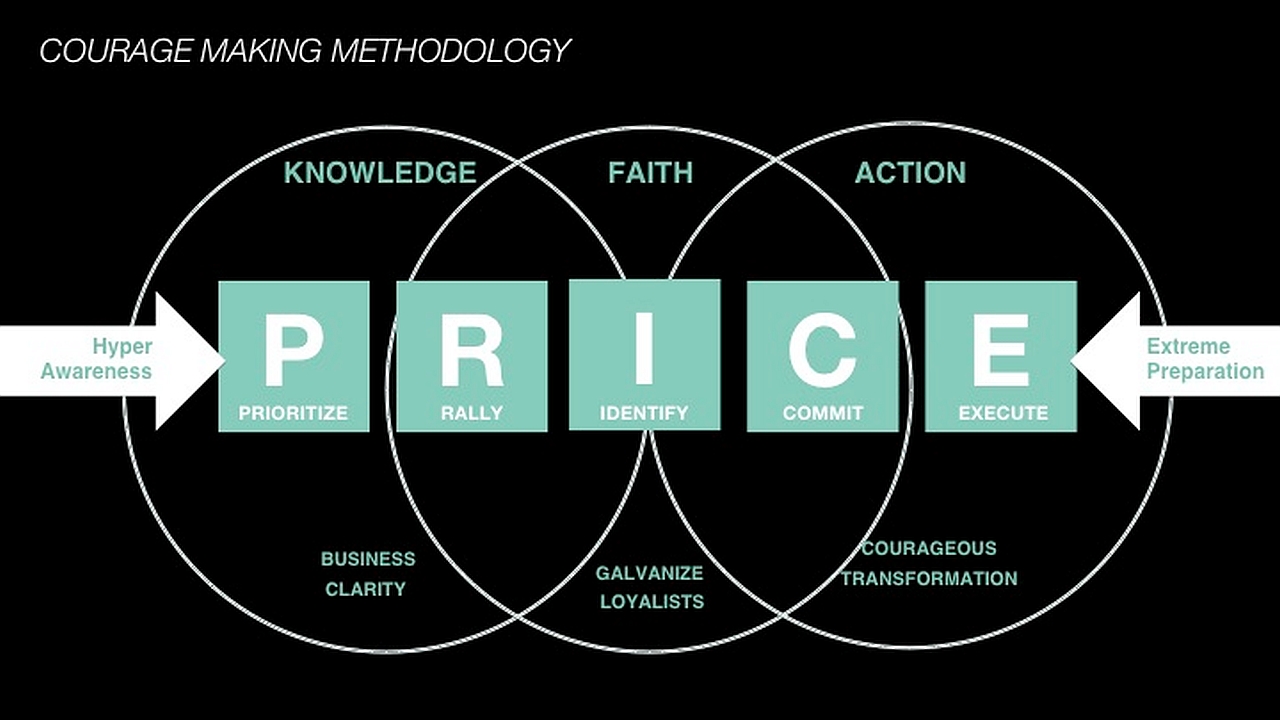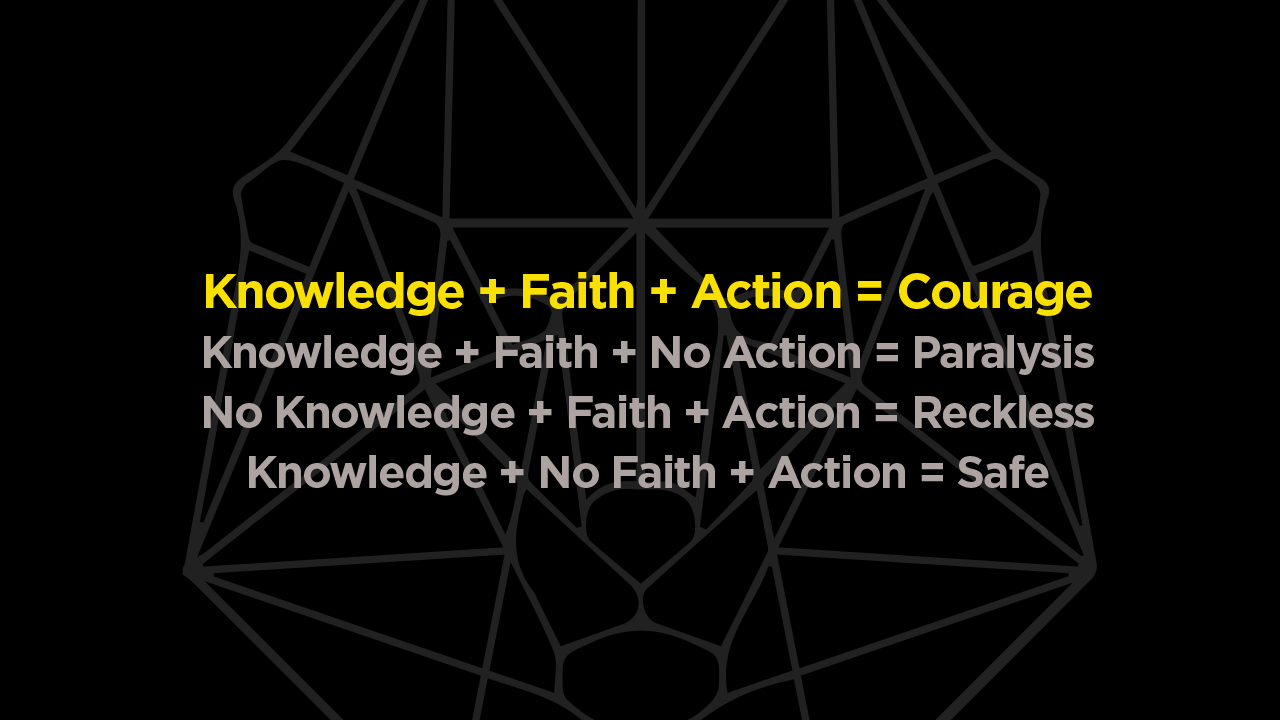I’m lucky. I have a troop of buddies from my New York City days that, thanks to technology, remain the closest of friends today. I’ll admit that the way we operate, there’s a lot of text chains, a lot of ribbing and a lot of laughs. My buddies and I used to text this one little quip to one another when someone would say something outdated on the chain:
“1985 called. They want their joke back.”
Although this group was talking about personal stuff, if I did have a successful business leaders group texting at the same pace, one thing we surely could be saying is, “2020 is on the line. They want their courage back.”
There’s a noticeable deficiency of courage in the business world. It is absent from business models, boardrooms, company cultures, and mission statements. Courageous leadership seems to have taken a sabbatical—and many businesses are far worse for it. Most terrifying of all, employees within an organization who aspire to make calculated courageous calls across a company are not getting the opportunity to do so. Their bold ideas are getting squashed along the way or, sadly, they’ve landed in a culture where iterative growth has become the goal throughout the hallways.
Instead of spending the next 1200 words delving deeper about “why” this is our current diagnosis, I’d prefer to simply tap into “how” we can help those willing and courageous leaders help their companies get their courage back. Effective leadership takes courage; Indeed, unlocking courage, when truly embraced and understood, can be your ultimate X factor and competitive advantage.
For my new book, RETURN ON COURAGE, I interviewed many bold and courageous leaders in business, along with some of the bravest people on earth. This included people within Amazon, Apple, Google, Live Nation, Method, Tuft & Needle, Virgin Galactic and Zappos. I can assure you, even as I was writing the book, that I never thought I’d come out the other side with a method that could help companies train their people on how to operationalize bold action so that they could return on courage.
For any willing being or business who aspires to transform their business into, what I call, a Courage Brand®, it comes with a P.R.I.C.E. For one, if it were easy everyone would do it. Two, P.R.I.C.E., as you already surmised, is an acronym that when followed, is the step-by-step plan that can help any company remove the silo that sits between organizational health and courageous business.
Let’s get into the method here:
PRIORITIZE THROUGH VALUES
Core values are modern-day rudders of decision-making. Most businesses, of course, have values. Not all are leading through them. Instead, these values are seen memorialized on a lobby wall or collecting dust in an employee manual. Core Values are not eye rolls. They’re how the exceptional roll. Core values help you take a stand in the messy, complication middle of a project. How do you know when to take a stand if you don’t know what you stand for? Other companies are honoring a value of a founder that is out of alignment today with the way people truly work, shop and live. Many businesses are missing the mark as to what the next generation truly values. Most must realize that the next generation won’t buy unless they buy in. With thousands of choices at their fingertips, the differentiator is valuing, declaring, and living your distinct core values. The ask? Go back to the basics and make sure you have the right values driving the behavior of your organization.
RALLY BELIEVERS
You’ve done the hard work to not only lock in your values, but also lead through them. Living the values at your company makes it easier to swiftly audit who is on your raft and, frankly, who isn’t. Leaders either make believers or fake believers. Fake Believers don’t wear a t-shirt around the office that says ‘Fake Believer.’ They just nod, smile and collect a paycheck. The path to creating a courageous culture runs through a leaders ability to create alignment and genuine conviction for the work you’re producing. This might be a good time to admit I have a gripe with the word leadership. Don’t get me wrong—we clearly need courageous leadership now. The problem is poor leaders turn leadership into cheerleadership. They start ra ra’ing to their staff which might work with a portion of your staff, but this behavior is a “no go” with your high producers. Making Believers all starts at the top with what I call your Believership. I prefer “Believership” because it’s not simply the job of one leader. The sole purpose of your Believership is to create Believers in all directions; out of your board, employees, prospects, and customers. There are multiple ways to make a Believer (vs a Fake Believer) which I cover in detail in Return On Courage. One final note on Fake Believers; frustrated Fake Believers are not bad people. They are just in the wrong place. Fake Believers should go work for people they can believe in. Of course, it’s hard to let go of someone who doesn’t fit anymore. When this is the case, ask yourself what is in the absolute best interest of the business.
IDENTIFY FEARS
There’s a famous proverb that fear and courage are brothers—you can’t get to the courageous move without first channeling through fear. Of course, most of us don’t want to think about those daunting challenges that could cripple your business. One of my favorite interviews for my book was with Virgin Galactic Astronaut, Loretta Hidalgo. Loretta shared, “Fear is just a piece of information. It’s evolutionary, created to protect you. Fear is not trying to hurt you.” When was the last time you audited what could take your entire vertical down (industry fear)? Where could your product simply be stronger (product fear)? Is your message and story not as sticky as you hoped for (perception fear)? Proactively smoke out and address your business fears so you can put a plan together to shrink them down vs, the alternative, which is having them take YOU down. As a Seinfeld fan, I’ll admit I enjoy being able to say I’m in the fear shrinkage business. Now is the time to make fear your friend. The businesses that win shrink fear. They turn ‘there’s no time like the present’ into ‘there’s no time but the present’.
COMMIT TO A PURPOSE
Simon Sinek got it right. It’s critical that we do the hard work to get clarity on our why. If I were to add on to this, it’s simply that courageous leaders must make sure they inject a rally cry inside that why. If you want your staff to stick around, you need to find that truthful, purposeful, emotional and differential purpose that makes employees want to come to work everyday. You can make a case that there’s no proof that SpaceX will succeed on fulfilling their “rally cry in their why” purpose of creating human life on another planet. But the people who choose to work for Musk are just as excited to be on a cultural rocket ship as much as working on literally rocket ships. They want that story and are willing to stick around for this all-encompassing worthy calling. We spend a lot of time in marketing talking about call to actions. But a call to action doesn’t galvanize a staff like a call for action.
EXECUTE YOUR ACTION
Without a doubt, the hardest part of it all is taking action. Remember, you’re never going to have every bit of knowledge served up to you on a silver platter to make a call. If you wait too long, you will most likely get past by a competitor. Trust the knowledge you have, which builds inner belief, to ultimately, help you take courageous action. If we’re going to have a conversation about courage we’re really have a conversation about change. Whether change is happening at the innovation level, the culture level or the story level, treat these change opportunities like experiments. Build an Experimental Task Force and, if you’re in an effective leadership role, grant them time, space and a budget to come back with recommendations on these experiments. This means allocating budget for experiments in annual planning (make it a line item). And for those experiments with promise, double down with more resources. Remember, as Marshall Goldsmith warns, what got you here, won’t get you there.
Being proactive, and following the 5 steps of P.R.I.C.E., can help you design a calculated plan to taking action on. And it might be the difference between being a stasis Coward Brand and a modern, calculated Courage Brand.

Courage: Knowledge, Faith and Action.
Knowledge, faith, and action are the matchstick, tinder, and wood that work together to form the fire that is courage. The sum of these parts—and it must include all of them—makes up courage. Courage always starts with knowledge. Obtaining knowledge is the true differentiator between doing something careless and embarking on something boldly calculated. It surely will be easier for you to take a risk if you are educated on the topic you need to be courageous about.
Since you’re never going to be able to gather all the available knowledge on a given topic, at some point you have to rely on that belief system of yours we’ll call faith. And once you build that faith, mixed in with just enough acquired knowledge, then it’s time to do something about it. This is when you take action. You need all three—knowledge, faith, and action—for real courage to be at play. Two out of three in any combination is not courageous. Here’s why:
Gathering knowledge, building faith, and then taking no action is paralysis. We’ve all been in situations where we knew what we needed to do but, for some unknown reason, didn’t pull the trigger. “Courage comes to those who act, not to those who think, wait, and wonder,” motivational maverick Grant Cardone says. “The only way to hone this trait is by taking action.”
Having faith and then taking action without proper knowledge is reckless. We’re back to jumping out of a plane without a parachute. Remember, courage always starts with obtaining wisdom. Maya Angelou reminds us to “do the best you can until you know better, then when you know better, do better.”
Gathering knowledge then taking action without having faith is simply too safe. This is status quo. If you don’t feel a bit of nervousness on the inside, in a world saturated with choice, it’s not enough. Acquiring knowledge, building faith, and taking action is courage.
The more you grow your knowledge and the more you grow your faith, the more courageous an action you should take. It’s almost like having an inside scoop on how a stock is going to perform. When knowledge, faith, and action are in place, and when intuition suggests they work together in harmony, invest!



